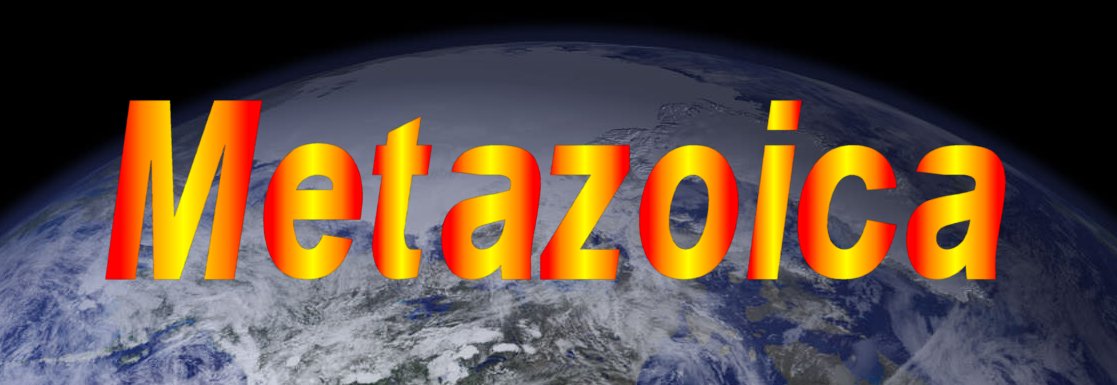Welcome to my Metazoic site! This site discusses the existence of the creatures to come along after humans will be extinct. I first became interested in a world after man when I acquired my first copy of Dougal Dixon's After Man: A Zoology of the Future in 1992. However, I unwittingly created creatures that did not exist from the time I was about 8 years old. But it was after I obtained a copy of that book (now a collector's item) that I decided to take these same creatures I created as a child and make them more realistic in an evolutionary sense. Though it may be hard for a lot of us to grasp, humans will soon become extinct. One of the biggest factors of how this will happen is the current overpopulation rate. Which is why I don't contribute to the population. I created this world with little more than mammals fulfilling all ecological niches with the help of some friends. I even gave the era of the age after man a name, I called it the Metazoic, derived from the words for "After-era" (Meta, meaning after, and zoic meaning era). We are now in the Cenozoic era. To view all the animals I have created since I began this project, you can go to the "Meet the Mammals" section of this site. To discuss your own ideas about what you think will happen in the future world, and share your ideas with others, please feel free to leave a comment.
One more thing, some of you may find this site quite offensive, and you have a right to your own opinion. But please respect my right to have an opinion too. I'm not saying there is no GOD, I believe it was HIM who got the ball rolling. But I believe after that, evolution took over. There is so much more evidence of evolution than there is of creation. Even that going on right under our noses. Other than that, enjoy yourself and visit our many links.
Tuesday, January 27, 2009
Ancestor For All Animals Identified
http://dsc.discovery.com/news/2009/01/27/animal-ancestor.html
Ancestor For All Animals Identified
Jennifer Viegas, Discovery News
Jan. 27, 2009 -- A sperm-looking creature called monosiga is the closest living surrogate to the ancestor of all animals, according to new research that also determined animal evolution may not always follow a trajectory from simple to complex.
Yet another find of the study, published in the latest PLoS Biology, is that Earth may have given rise to two distinct groups of animals: bilaterians -- animals with bilateral symmetry, like humans -- and non-bilaterians, which include corals, jelly fish, hydra, unusual, often poisonous, creatures known as cubozoans, and other organisms.
Free-living, unicellular organisms called choanoflagellates, however, could be on every person's family tree, so long as it was a gigantic one.
"It is clear that the choanoflagellates -- living representative is monosiga -- are the best candidate for the nearest relative of animals," co-author Rob DeSalle told Discovery News.
"So a choanoflagellate-like organism could be looked at as a probable common ancestor for animals," added DeSalle, curator at the Sackler Institute for Comparative Genomics at the American Museum of Natural History.
He and his colleagues compiled data from multiple gene sequences derived from many sources to find over 9,400 variable characters that contain parsimony information, which collectively refers to the shared, derived traits that help biologists infer species relationships on the tree of life.
They determined that so-called "simple" and "lower" tier animals, such as corals and jellyfish, evolved in parallel to "higher" animals, like seemingly more complex insects and even humans. On the tree of life, monosiga then currently holds the root position for the latter group.
The new research completely shakes up the non-bilaterian animal ordering. Previously it was thought that either super simple-structured or comb jellies were at the root of the non-bilaterian animal tree. Instead, complete outsiders -- placozoans -- have been placed in that basal position.
First discovered gliding along glass in laboratory aquariums just over 100 years ago, placozoans are animals that lack a nervous system and possess four types of body cells.
DeSalle explained that, "placozoa, because of their simple body plans and their position in our tree, are a good candidate for the common ancestor of non-bilaterian animals."
Although non-bilaterians and bilaterians appear to have followed separate evolutionary paths, nervous systems appear in both groups. Placozoans and sponges don't possess them, but many of their closely related taxa do.
"So this means that if our work is right, nervous systems evolved twice: Once in the lineage leading to bilateria and once in the lineage leading to corals, jelly fish, hydra and cubozoa," he said.
Neil Blackstone, professor of ecology and evolution at Northern Illinois University, told Discovery News, "There is no doubt that Rob and his colleagues are leaders in the study of evolutionary relationships among animals."
Blackstone agreed that, "evolution need not be progressive. Perhaps there are two fundamentally different kinds of animals."
He added, "This makes the early history and evolution of animals more, not less, interesting."

No comments:
Post a Comment